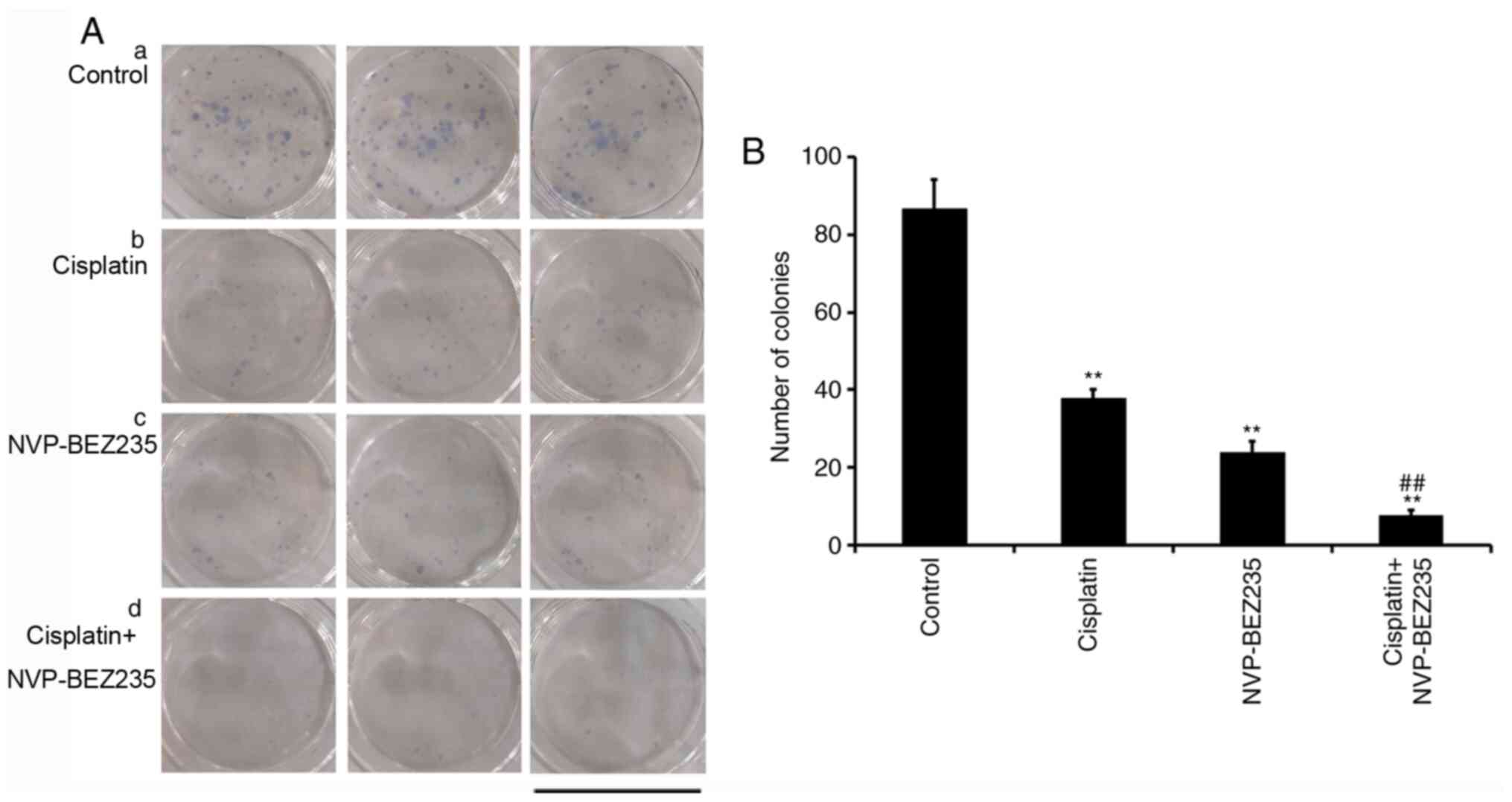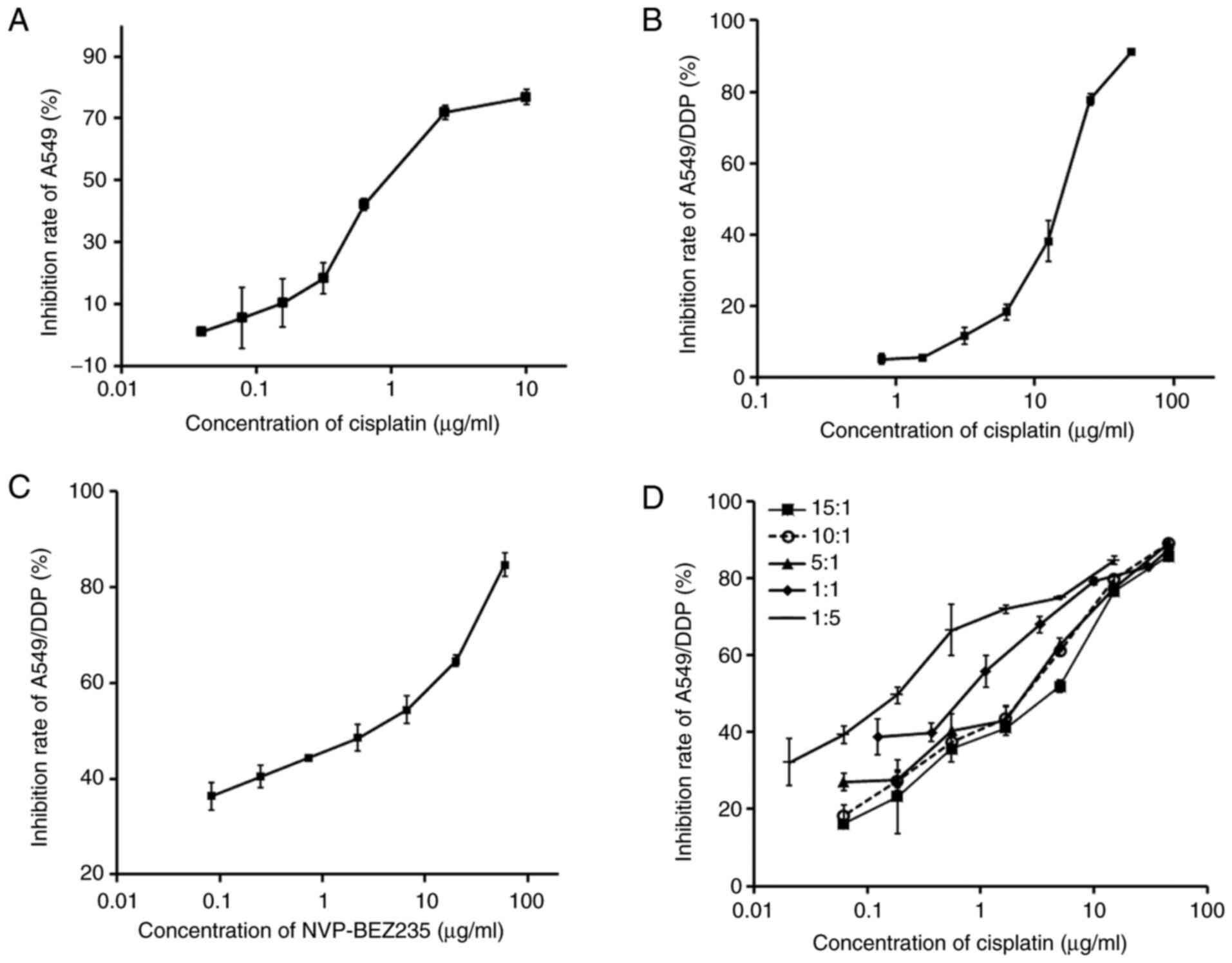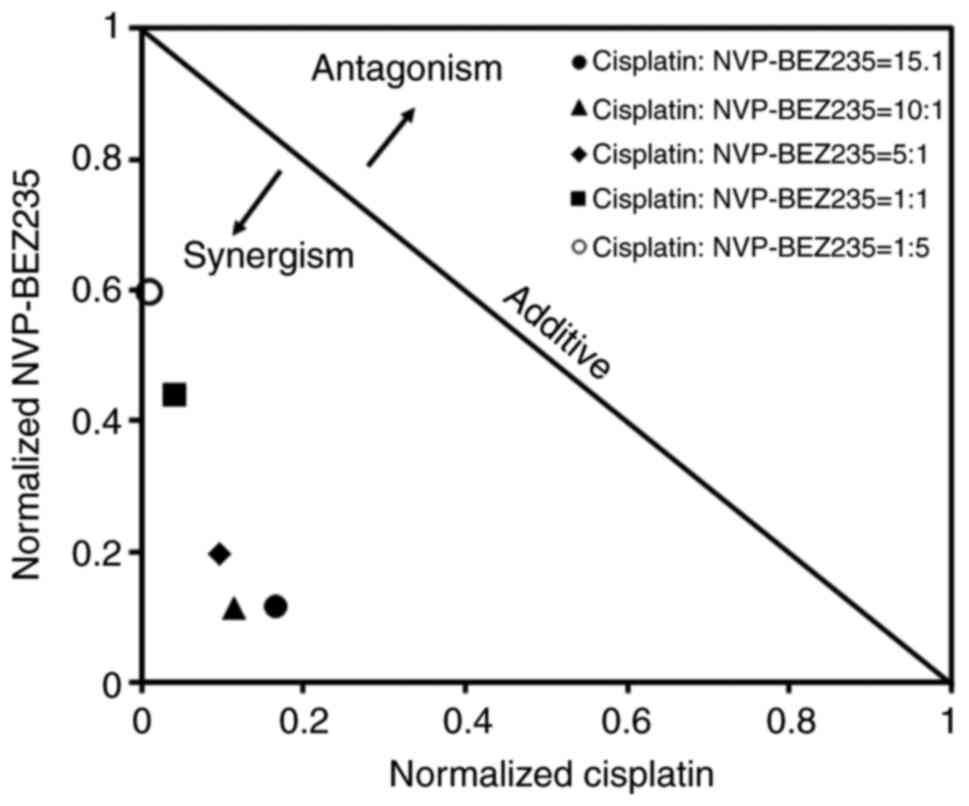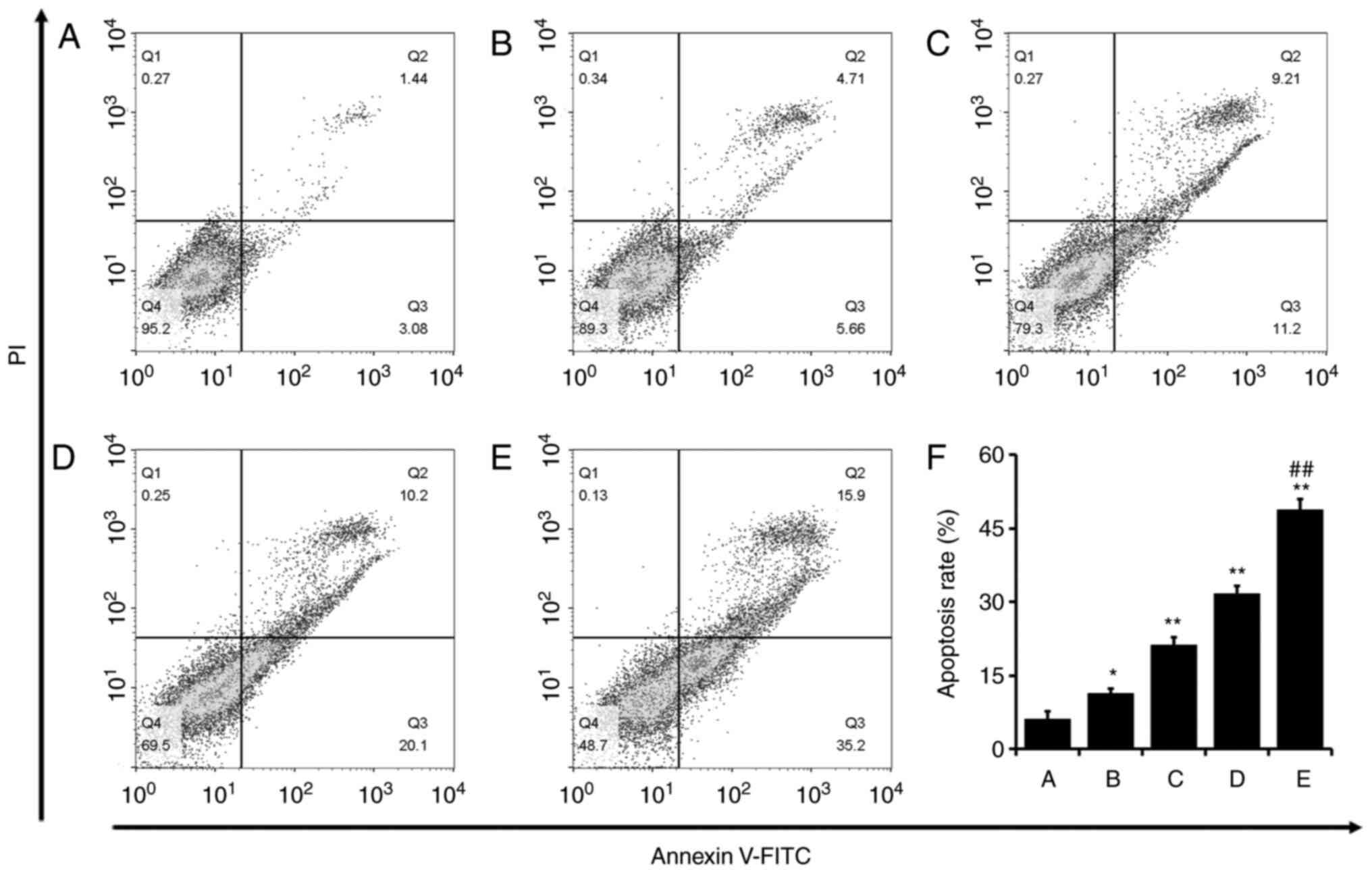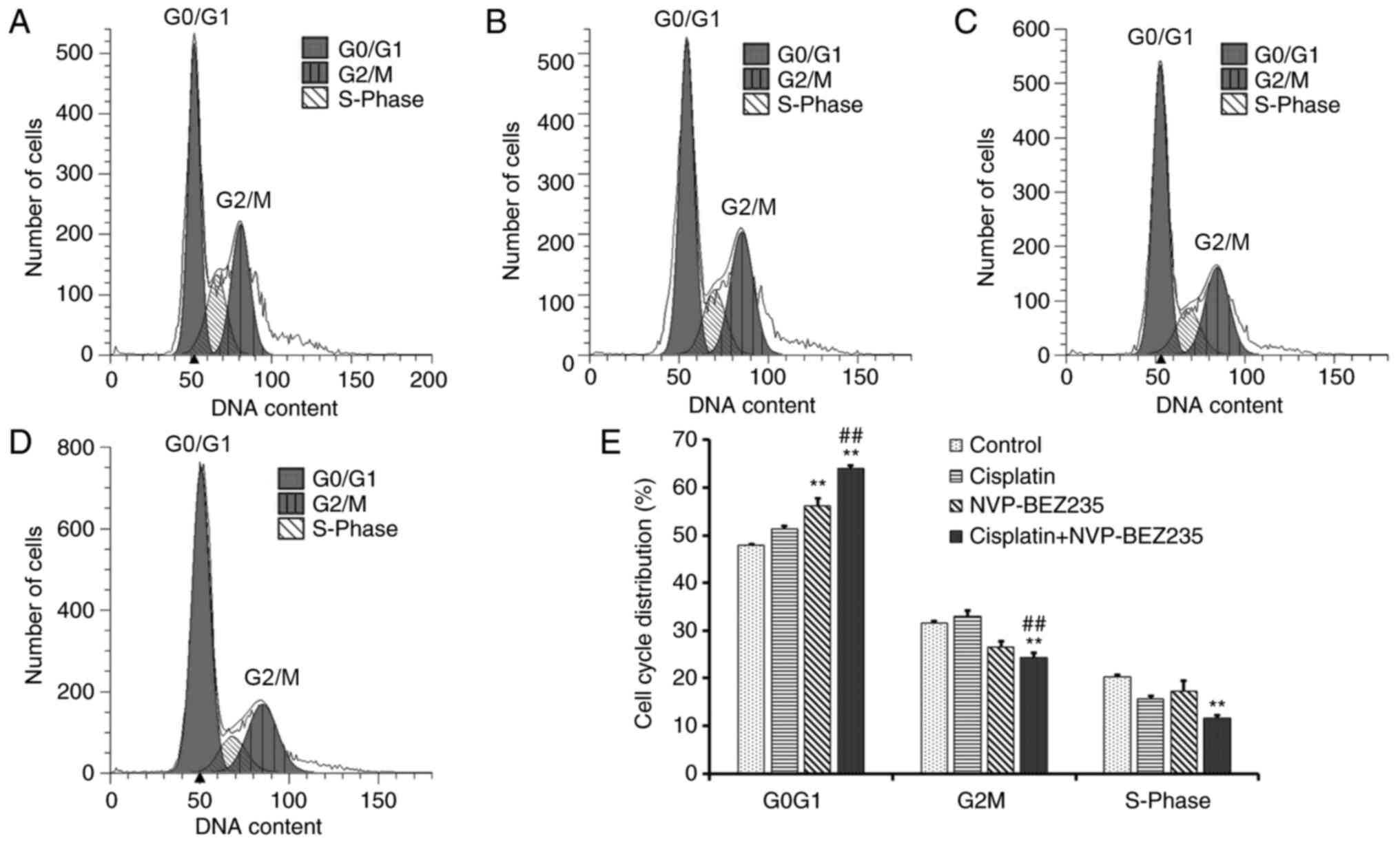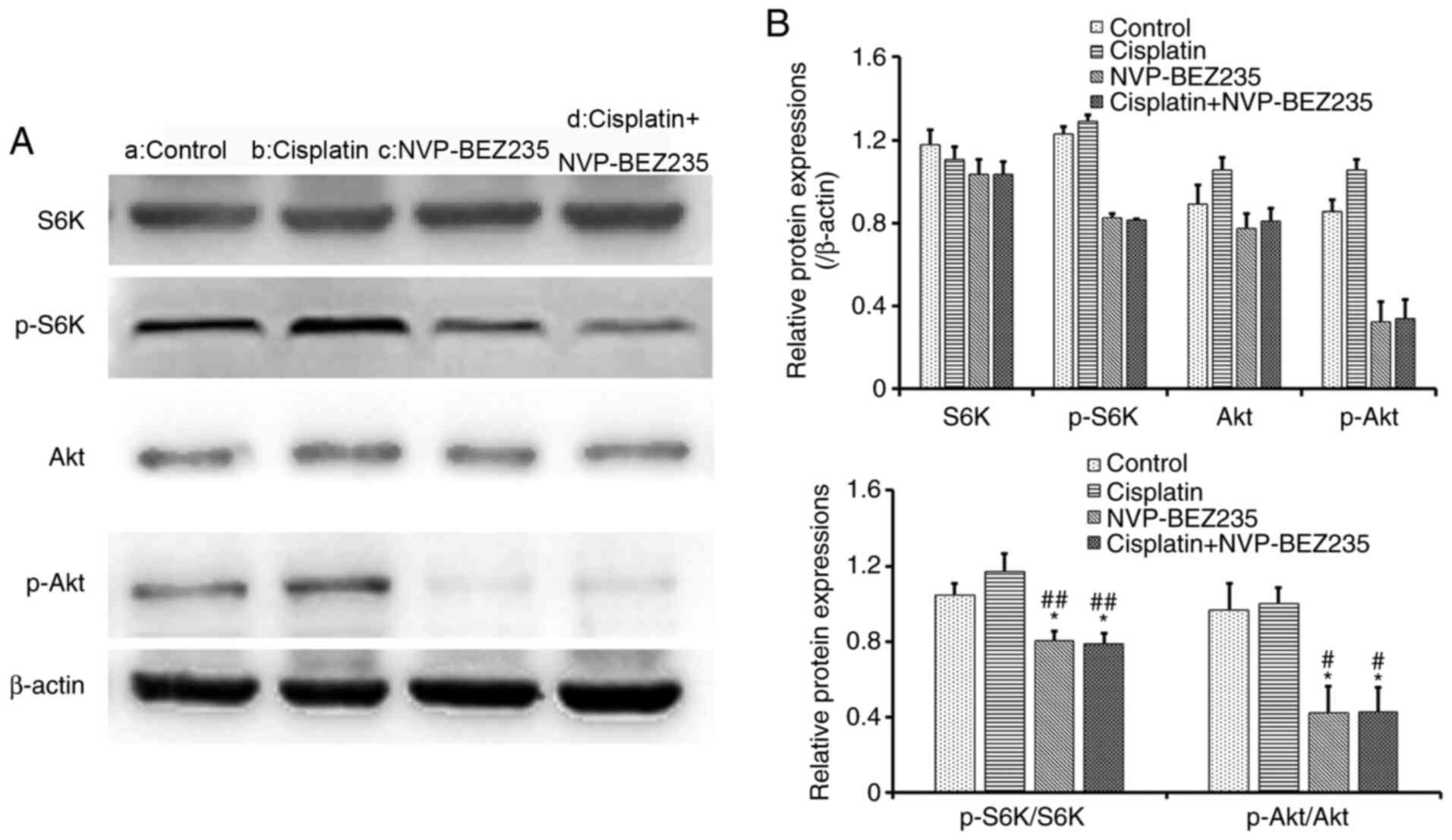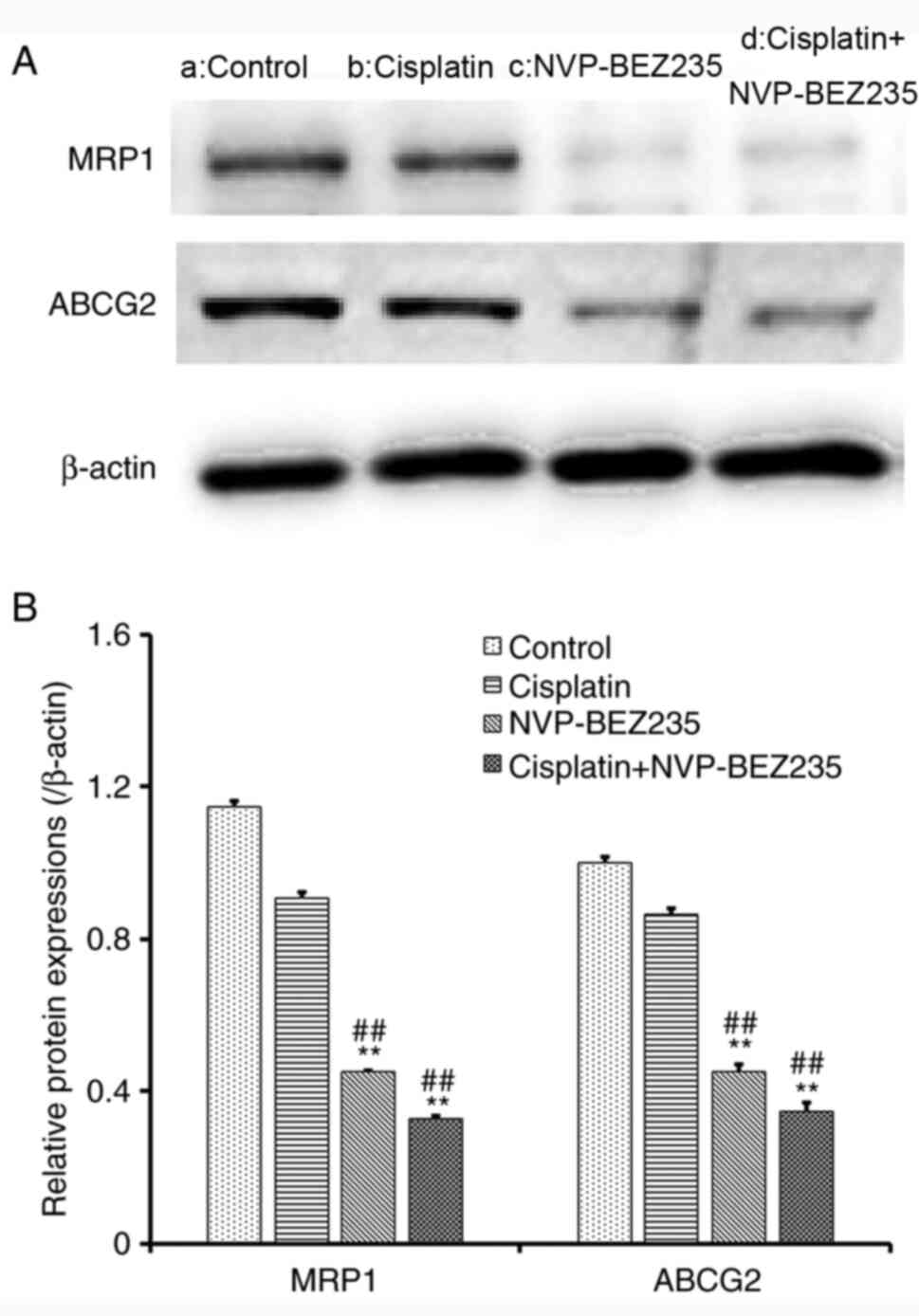Introduction
Lung cancer is one of the most common malignant
tumors, with the highest incidence (11.6%) and mortality rates
(18.4%) according to the GLOBOCAN 2018 estimates of cancer
incidence and mortality produced by the International Agency for
Research on Cancer (1). Lung cancer
can be divided into two primary types: Non-small cell lung cancer
(NSCLC) and small cell lung cancer (2) It is estimated that ~83% of patients
with lung cancer suffer from NSCLC, and 65% of patients with NSCLC
are diagnosed when the disease is already in an advanced or
metastatic stage, which often results in a poor prognosis (2,3).
Up to now, platinum-based adjuvant chemotherapy
after complete resection has become a standard treatment strategy
for patients with stage II–IIIA NSCLC and for individuals who
cannot be treated with targeted cancer therapy (4,5).
Cis-diamminedichloroplatinum (DDP; cisplatin), one of the most
widely used platinum-based drugs for lung cancer, can kill cancer
cells by interfering with DNA synthesis and RNA transcription to
induce cell apoptosis (6).
Nevertheless, the prognosis of patients with advanced or metastatic
NSCLC treated with cisplatin alone is poor (7) One of the challenges for the
effectiveness of cisplatin treatment is drug resistance, which may
be intrinsic or acquired after several cycles of chemotherapy. As a
result, increasing the dose of chemotherapeutic agents does not
improve therapeutic efficacy, but may cause severe side effects and
lead to chemotherapy failure (8).
The mechanisms underlying drug resistance are complicated and are
not completely understood. Possible mechanisms might include
overactivation of the PI3K/Akt/mTOR signaling pathway and
overexpression of drug efflux proteins, such as ATP-binding
cassette (ABC) transporters (9–12). At
present, using a combination of two or more chemotherapeutic drugs
is an effective strategy to improve the efficacy of chemotherapy
and reverse drug resistance in different tumors (13–16).
Recently, the PI3K/Akt/mTOR signaling pathway has
emerged as a crucial signaling pathway in cancer cell
proliferation, metabolism, migration, angiogenesis and metastasis
(17). Upregulation of the signaling
pathway has been associated with poor prognosis in patients with
cancer and may even confer resistance to chemotherapy in various
tumors, including breast cancer, colorectal cancer and lung cancer
(9,18,19).
Therefore, targeting the PI3K/Akt/mTOR signaling pathway using
specific kinase inhibitors serves as a pivotal approach for
drug-resistant cancer treatment (19–22).
Upregulation of ABC transporters is another major cause for
chemoresistance of different types of cancer, such as
hepatocellular carcinoma and colorectal carcinoma (23). The ABC transporters are cell membrane
proteins that can efflux chemotherapeutic agents out of cancer
cells in an ATP-dependent manner, and ultimately lead to reduced
intracellular accumulation of drugs and chemotherapy failure
(11,12,24). The
ABC transporter super family consists of several members based on
their structure. Among them, ABCB1 (P-glycoprotein), ABCC1
[multidrug resistance-associated protein 1 (MRP1)] and ATP-binding
cassette sub-family G member 2 (ABCG2) are the most frequently
upregulated proteins in cancer cells (25,26).
Notably, researchers also demonstrated that various signaling
molecules, such as ERK1/2, PI3K/Akt and NF-κB (p65), can regulate
the expression of ABC transporters, such as ABCC1 (27) The aforementioned findings indicate
that inhibiting the PI3K/Akt/mTOR signaling pathway and reducing
the expression of drug efflux transporters in drug-resistant tumor
cells may effectively induce cell death and reverse drug
resistance.
NVP-BEZ235, a novel dual PI3K/Akt/mTOR inhibitor,
which overcomes certain intrinsic disadvantages of single Akt or
mTOR inhibitors, can kill various cancer cells via inhibiting dual
PI3K/Akt and mTOR signaling pathways (28). Several researchers have reported that
NVP-BEZ235 can reverse different types of drug-resistant cancer,
such as multidrug-resistant acute myeloid leukemia cell lines, the
cisplatin-resistant triple negative breast cancer cell line (HCC38)
and cisplatin-resistant human bladder cancer cell lines (20,21,29).
Furthermore, combined treatment of NVP-BEZ235 and chemotherapeutic
agents displayed significant synergistic effects on drug-resistant
tumors (30). Currently, only one
report has suggested that there is a synergistic action between
NVP-BEZ235 and cisplatin in cisplatin-resistant NSCLC A549 cell
(31). Nevertheless, the mechanisms
have not been fully explained and elucidated.
The present study initially evaluated the
synergistic antiproliferative effects of cisplatin and dual
PI3K/Akt/mTOR inhibitor NVP-BEZ235 on the cisplatin-resistant NSCLC
A549 cell line in vitro. Furthermore, the underlying
cellular mechanism was investigated.
Materials and methods
Cell culture
The human NSCLC cell line (A549) and a
cisplatin-resistant cell line (A549/DDP) were obtained from The
Cell Bank of Type Culture Collection of the Chinese Academy of
Sciences. Cells were cultured in a humidified atmosphere with 5%
CO2 at 37°C in RPMI-1640 medium (Hyclone; Cytiva)
supplemented with 10% FBS (Gibco; Thermo Fisher Scientific, Inc.),
100 U/ml penicillin and 100 mg/ml streptomycin (Gibco; Thermo
Fisher Scientific, Inc.). A549/DDP cells were maintained in the
aforementioned medium containing 1.5 µg/ml cisplatin
(Sigma-Aldrich, Merck KGaA).
Chemicals and reagents
NVP-BEZ235 was purchased from Selleck Chemicals.
DMSO was purchased from Aladdin Industrial Co., Ltd. (https://www.aladdin-e.com) Cisplatin was purchased
from Sigma-Aldrich (Merck KGaA). The Cell Counting Kit-8 (CCK-8)
assay, BCA Protein Assay kit, Cell Cycle Analysis kit, Annexin
V-FITC Apoptosis Detection kit, RIPA lysis buffer and SDS-PAGE
protein-loading buffer (5X) were purchased from Beyotime Institute
of Biotechnology. Giemsa stain was purchased from Shanghai Fushen
Biotechnology Co., Ltd. The monoclonal Akt (cat. no. 4691S),
phosphorylated (p)-Akt (cat. no. 2965S), p70-S6 Kinase (p70S6K;
S6K; cat. no. 2708S), p-p70 S6 Kinase (p-p70S6K; p-S6K; cat. no.
9234S), ABCG2 (cat. no. 42078S), MRP1 (cat. no. 14685S) and β-actin
(cat. no. 4970S) rabbit antibodies were purchased from Cell
Signaling Technology, Inc. All primary antibodies were used at a
dilution of 1:1,000. The HRP-labeled goat anti-rabbit IgG secondary
antibody (cat. no. 111-035-003) was purchased from Jackson
ImmunoResearch Laboratories, Inc. The secondary antibody was used
at a dilution of 1:5,000.
Cell proliferation assay
NVP-BEZ235 was dissolved in DMSO to obtain a 1 mg/ml
stock concentration. Cisplatin was dissolved in DMSO to obtain a 10
mg/ml stock concentration. Both NVP-BEZ235 and cisplatin stock
solutions were stored at −20°C before use and then further diluted
in RPMI-1640 media to the desired concentrations (cisplatin,
0.04~50 µg/ml; NVP-BEZ235, 0.08~60 µg/ml). As a control, cells were
incubated with fresh media containing an equal volume of DMSO (an
equal volume of DMSO to media).
Cell proliferation in vitro was measured by
performing the CCK-8 assay, according to the manufacturer's
protocol. Briefly, A549 and A549/DDP cells were seeded
(5×103 cells/well) into 96-well plates and allowed to
adhere overnight in a humidified atmosphere with 5% CO2
at 37°C. Subsequently, cell media was removed and cells were
treated at 37°C for 48 h with different concentrations of cisplatin
and NVP-BEZ235. After incubation, cells were washed with PBS and 15
µl CCK-8 reagent was added to each well for 2 h at 37°C. Samples
were analyzed using a Bio-Rad 680 microplate reader (Bio-Rad
Laboratories, Inc) at a wavelength of 450 nm with a reference
wavelength (650 nm). The inhibitory rates on cell proliferation
were calculated according to the following equation: Inhibition
rate (%) = [(A450control-A450sample) /
(A450control)] ×100.
Combinatorial effects of cisplatin and
NVP-BEZ235
The proliferative effects of drug combinations were
evaluated by performing the CCK-8 assay. Briefly, A549/DDP cells
were seeded (5×103 cells/well) into 96-well plates and
allowed to adhere overnight in a humidified atmosphere with 5%
CO2 at 37°C. Subsequently, cell media was replaced with
drugs of different mass ratios (cisplatin:NVP-BEZ235 at 15:1, 10:1,
5:1, 1:1 or 1:5) at various concentrations (cisplatin, 0.02~45
µg/ml; NVP-BEZ235, 0.004~75 µg/ml). Control cells were incubated
with fresh media containing an equal volume of DMSO. Clinically,
drug dosage is calculated by mass ratios, instead of molar ratios.
Thus, mass ratios were selected in the present study. Cells were
incubated at 37°C for 48 h. Following incubation, cells were washed
with PBS and 15 µl CCK-8 reagent was added to each well for 2 h at
37°C. Samples were analyzed using a microplate reader at a
wavelength of 450 nm with a reference wavelength. The inhibitory
rates on cell proliferation were calculated according to the
following equation: Inhibition rate (%) =
[(A450control-A450sample)/(A450control)]
×100.
Combination index analysis (CI) was used to assess
the synergistic antitumor effects of cisplatin and NVP-BEZ235 in
A549/DDP cells. CI was calculated according to the following
formula: CIx=(Dose)1/(Dosex)1 +
(Dose)2/(Dosex)2, where
(Dose)1 and (Dose)2 represent the dose of
drug 1 (cisplatin) and drug 2 (NVP-BEZ235) in combination therapy
that inhibit x% cells, respectively, whereas
(Dosex)1 and (Dosex)2 represent
the dose of drug 1 (cisplatin) and drug 2 (NVP-BEZ235) in single
drug treatment to inhibit x% cells, respectively. CI<1,
CI=1 and CI>1 indicated synergistic, additive and antagonistic
effects of the combination therapy compared with single drug
treatment, respectively.
Colony formation assay
A549/DDP cells were seeded (5×102
cells/well) in 6-well plates in triplicate, and cells were allowed
to adhere overnight in a humidified atmosphere with 5%
CO2 at 37°C. Cell media was replaced with drug-free
fresh media (control), cisplatin (1.53 µg/ml), NVP-BEZ235 (0.15
µg/ml) or cisplatin + NVP-BEZ235 (cisplatin:NVP-BEZ235 at 10:1;
cisplatin, 1.53 µg/ml) and cells were incubated at 37°C for 24 h.
Subsequently, cell media was discarded and replaced with drug-free
media. Adhered cells were cultured at 37°C for 7 days and fresh
drug-free media was replaced every 2 days. At the indicated time
points, cells were fixed in 70% ethanol for 10 min at 4°C and
stained with Giemsa stain for 15 min at room temperature.
Subsequently, colonies (clusters >50 cells) were observed and
counted under a light microscope (magnification, ×40; Olympus
Corporation). The images presented in Fig. 3A were obtained using a digital
camera.
Cell apoptosis (early + late
apoptosis) analysis
A549/DDP cells were seeded (2×106
cells/well) into 6-well plates in triplicate and allowed to adhere
overnight in a humidified atmosphere with 5% CO2 at
37°C. Cell media was replaced with drug-free fresh media (control),
cisplatin (1.53 µg/ml), NVP-BEZ235 (0.15 µg/ml), cisplatin +
NVP-BEZ235 low dose (cisplatin:NVP-BEZ235 at 10:1; cisplatin, 1.53
µg/ml) or cisplatin + NVP-BEZ235 high dose (cisplatin:NVP-BEZ235 at
10:1; cisplatin, 3.06 µg/ml), and cells were incubated at 37°C for
24 h. After incubation, cells were washed with PBS, collected and
double stained with Annexin V-FITC and PI. The kit was used
according to the manufacturer's protocol. Apoptotic cells were
analyzed using a BD LSRFortessa flow cytometer (Becton Dickinson
and Company) and Cell Quest software (version 5.2; Becton Dickinson
and Company). A total of 1×104 cells were recorded for
each sample. Data were analyzed using FlowJo software (VX10; Becton
Dickinson and Company).
Cell cycle analysis
A549/DDP cells were seeded (2×106
cells/well) into 6-well plates in triplicate and allowed to adhere
overnight in a humidified atmosphere with 5% CO2 at
37°C. Cell media was replaced with drug-free fresh media (control),
cisplatin (1.53 µg/ml), NVP-BEZ235 (0.15 µg/ml) or cisplatin +
NVP-BEZ235 (cisplatin:NVP-BEZ235 at 10:1; cisplatin, 1.53 µg/ml),
and cells were incubated at 37°C for 24 h. After incubation, cells
were harvested via centrifugation (1,000 × g, 4°C, 5 min) and
washed with ice-cold PBS. Subsequently, cells were incubated with
25 µg/ml PI and 10 µg/ml RNase for 30 min at room temperature in
the dark room. The samples were analyzed using a BD LSRFortessa
flow cytometer (Becton Dickinson and Company) and CellQuest
software (version 5.2; Becton Dickinson and Company). A total of
1×104 cells were recorded for each sample. Data were
analyzed using ModFit LT software(version 5.0; Verity Software
House, Inc.).
Western blot analysis
A549/DDP cells were seeded (2×106
cells/well) into 6-well plates in triplicate and allowed to adhere
overnight in a humidified atmosphere with 5% CO2 at
37°C. Cell media was replaced with drug-free fresh media (control),
cisplatin (1.53 µg/ml), NVP-BEZ235 (0.15 µg/ml) or cisplatin +
NVP-BEZ235 (cisplatin:NVP-BEZ235 at 10:1; cisplatin, 1.53 µg/ml),
and incubated at 37°C for 24 h. After incubation, cells were washed
with PBS and lysed with RIPA lysis buffer (Beyotime Institute of
Biotechnology), containing 1 mM PMSF (Beyotime Institute of
Biotechnology) and phosphatase inhibitor (1 tablet dissolved in 10
ml RIPA lysis buffer; Roche Diagnostics GmbH). Total protein was
quantified using the BCA protein Assay kit. Equal amounts of
proteins (20 µg protein/lane) were separated via 8% SDS-PAGE and
transferred onto PVDF membranes. Subsequently, the membranes were
blocked in tris-buffered saline with 0.1% Tween-20 (TBS-T) buffer
solution containing 5% skimmed milk for 2 h at room temperature,
followed by washing with TBS-T a further three times. The membranes
were incubated with primary antibodies, including antibodies
targeted against Akt, p-Akt, p70S6K, p-p70S6K, ABCG2, MRP1 and
β-actin, overnight at 4°C. The membranes were washed with TBS-T and
then incubated with a HRP-labeled goat anti-rabbit IgG secondary
antibody for 1 h at room temperature. Protein bands were visualized
using a Fusion FX7Spectra enhanced chemiluminescence system (Vilber
Lourmat Deutschland GmbH). The intensity of the bands was
semi-quantified using ImageJ software (1.48v; National Institutes
of Health) with β-actin as the loading control.
Statistical analysis
All experiments were performed in triplicate. Data
are presented as the mean ± SD. Statistical analyses were preformed
using SPSS software (version 21; IBM Corp). Comparisons among
multiple groups were analyzed using one-way analysis of variance
followed by Bonferroni's post hoc test. P<0.05 was considered to
indicate a statistically significant difference.
Results
Co-treatment of cisplatin and
NVP-BEZ235 synergistically inhibits A549/DDP cell
proliferation
A CCK-8 assay kit was used to evaluate the
antiproliferative effects of cisplatin and NVP-BEX235. The effects
of cisplatin, NVP-BEZ235 and combinations of cisplatin and
NVP-BEZ235 with different mass ratios (15:1, 10:1, 5:1, 1:1 or 1:5)
on A549/DDP cells were tested. The inhibitory effects of cisplatin
on A549 and A549/DDP cells were dose-dependent (Fig. 1A and B). The half maximal inhibitory
concentration (IC50) of cisplatin on A549 cells was 1.36
µg/ml (Table I). The IC50
of cisplatin on A549/DDP cells was 13.29 µg/ml. A549/DDP cells
displayed strong resistance to cisplatin treatment and the index of
drug resistance (IDR) of cisplatin on A549/DDP cells was 9.77. IDR
was calculated using the following formula: IDR = IC50
(A549/DDP)/IC50 (A549), as presented in Table I.
 | Table I.IC50 and IDR of cisplatin
on A549/DDP cells (n=3). |
Table I.
IC50 and IDR of cisplatin
on A549/DDP cells (n=3).
| Cell | IC50
(µg/ml) | IDR |
|---|
| A549 | 1.36 | – |
| A549/DDP | 13.29 | 9.77 |
CI was adopted to evaluate whether combiantion
treatment of cisplatin and NVP-BEZ235 had synergistic (CI<1),
additive (CI=1) or antagonistic (CI>1) effects on A549/DDP
cells. The IC50 of NVP-BEZ235 was 1.33 µg/ml, which
indicated apparent toxicity on A549/DDP cells (Fig. 1C and Table II). A total of five different mass
ratios of cisplatin and NVP-BEZ235 were used to test the
combinatorial effects of cisplatin and NVP-BEZ235 on A549/DDP
cells, and the results are presented in Fig. 1D and Table II. The CI values were between
0.2–0.7, which indicated a synergistic effect. A dose-normalized
isobologram for the two drugs was constructed (Fig. 2). Cisplatin and NVP-BEZ235 displayed
the strongest synergy (CI50=0.23) when they were
delivered at a mass ratio of 10:1. The concentrations of cisplatin
and NVP-BEZ235 were 1.53 and 0.15 µg/ml, respectively.
 | Table II.Concentrations of cisplatin and
NVP-BEZ235 at a 50% inhibition rate against A549/DDP cells for
different mass ratios and the corresponding CI (n=3). |
Table II.
Concentrations of cisplatin and
NVP-BEZ235 at a 50% inhibition rate against A549/DDP cells for
different mass ratios and the corresponding CI (n=3).
| Treatment | Concentration of
cisplatin (µg/ml) 50% inhibition | Concentration of
NVP-BEZ235 (µg/ml) 50% inhibition |
CI50 |
|---|
| Cisplatin | 13.29 | – | – |
| NVP-BEZ235 | – | 1.33 | – |
|
Cisplatin:NVP-BEZ235 at 15:1 | 2.23 | 0.15 | 0.28 |
|
Cisplatin:NVP-BEZ235 at 10:1 | 1.53 | 0.15 | 0.23 |
|
Cisplatin:NVP-BEZ235 at 5:1 | 1.28 | 0.26 | 0.29 |
|
Cisplatin:NVP-BEZ235 at 1:1 | 0.58 | 0.58 | 0.48 |
|
Cisplatin:NVP-BEZ235 at 1:5 | 0.16 | 0.79 | 0.61 |
Co-treatment of cisplatin and
NVP-BEZ235 inhibits A549/DDP cell colony formation
A549 cells were incubated with cisplatin (1.53
µg/ml), NVP-BEZ235 (0.15 µg/ml) or cisplatin + NVP-BEZ235
(cisplatin:NVP-BEZ235 at 10:1; cisplatin, 1.53 µg/ml) for 24 h.
Subsequently, cell media was discarded and adherent cells were
cultured in fresh media for 7 days for colony formation. Clusters
of >50 cells were considered as valid colonies (Fig. 3A). The number of colonies for each
group was counted (Fig. 3B). The
number of colonies was significantly reduced (P<0.001) in
drug-treated groups compared with the control group, which
indicated that both cisplatin and NVP-BEZ235 inhibited A549/DDP
cell colony formation. Specifically, compared with the cisplatin
group, combined treatment of cisplatin and NVP-BEZ235 displayed
further inhibitory effects on colony formation, as indicated by a
reduced number of colonies.
Co-treatment of cisplatin and
NVP-BEZ235 induces A549/DDP cell apoptosis
A549/DDP cells were incubated with cisplatin (1.53
µg/ml), NVP-BEZ235 (0.15 µg/ml) or cisplatin + NVP-BEZ235 (low or
high dose) for 24 h. Cell apoptosis assays were performed using the
Annexin V-FITC/PI double staining method. Q2, Q3 and Q4 represented
different stages of the cell cycle (Fig.
4A-E). Q2 and Q3 indicate late and early cell apoptosis,
respectively, and the total apoptosis rates were the sum of Q2 and
Q3 (Fig. 4F). Apoptosis rates were
significantly increased in the cisplatin (P<0.05), NVP-BEZ235
(P<0.001) and cisplatin + NVP-BEZ235 (low or high dose;
P<0.001) groups compared with the control group. Specifically,
the cisplatin + NVP-BEZ235 (high dose) group displayed
significantly increased apoptotic rates compared with the cisplatin
group. The results indicated that NVP-BEZ235 induced A549/DDP cell
apoptosis and a combination of cisplatin and NVP-BEZ235 further
increased A549/DDP cell apoptosis.
Co-treatment of cisplatin and
NVP-BEZ235 induces cell cycle arrest at the
G0G1 phase
A549/DDP cells were incubated with cisplatin (1.53
µg/ml), NVP-BEZ235 (0.15 µg/ml) and cisplatin + NVP-BEZ235
(cisplatin:NVP-BEZ235 at 10:1; cisplatin, 1.53 µg/ml) for 24 h and
analysis of the cell cycle distribution was conducted via flow
cytometry. G0G1, G2M and S phases
were analyzed separately (Fig.
5A-E). The number of cells in the G0G1
phase was increased significantly in the NVP-BEZ235 (P<0.001)
and cisplatin + NVP-BEZ235 (P<0.001) groups compared with the
control group. The number of cells in the G2M and S
phases was decreased significantly in the cisplatin + NVP-BEZ235
(P<0.001) group compared with the control group. The results
indicated that combined treatment of NVP-BEZ235 and cisplatin could
induce cell cycle arrest at the G0G1
phase.
Co-treatment of cisplatin and
NVP-BEZ235 reduced the phosphorylation of Akt and S6K protein
Western blot analysis of A549/DDP cells incubated
with cisplatin (1.53 µg/ml), NVP-BEZ235 (0.15 µg/ml) and cisplatin
+ NVP-BEZ235 (cisplatin:NVP-BEZ235 at 10:1, cisplatin: 1.53 µg/ml)
for 24 h was conducted (Fig. 6A).
The relative protein expression levels were then analyzed and
normalized to the expression levels of β-actin. The expression
levels of p-Akt and p-S6K were further normalized to the expression
levels of total Akt and S6K (Fig.
6B). Cisplatin treatment alone (1.53 µg/ml) did not
significantly alter the expression of p-Akt or p-S6K compared with
the control group (Fig. 6).
Cisplatin treatment did not inhibit the PI3K/Akt/mTOR signalling
pathways. Compared with the control and cisplatin groups,
NVP-BEZ235, a dual PI3K/Akt and mTOR inhibitor, decreased the
expression levels of p-Akt and p-S6K (P<0.05) and inhibited the
PI3K/Akt/mTOR signalling pathway, which suggests that NVP-BEZ235
may inhibit tumour growth. However, the NVP-BEZ235 + cisplatin
group did not further reduce the phosphorylation of Akt and S6K
compared with NVP-BEZ235 treatment alone. The results indicated
that NVP-BEZ235 might display antiproliferative effects on A549/DDP
cells via inhibition of the PI3K/Akt and mTOR signaling
pathways.
Co-treatment of cisplatin and
NVP-BEZ235 reduced the expression of drug efflux proteins
The expression levels of the ABC binding cassette
transporter proteins MRP1 and ABCG2 in A549/DDP cells were further
investigated via western blot analysis (Fig. 7A-B). Cells exposed to NVP-BEZ235
alone or combined treatment of cisplatin and NVP-BEZ235 displayed
significantly reduced protein expression levels of MRP1 and ABCG2
compared with the control and cisplatin groups. The results
suggested that NVP-BEZ235 might reverse the drug resistance of
NSCLC cells by inhibiting the drug efflux protein, leading to drug
accumulation in A549/DDP cells and more toxic effects.
Discussion
At present, lung cancer remains a great threat to
people's health, especially NSCLC, which accounts for 75–80% of
lung cancers (32). However, the
outcomes of standard chemotherapy for NSCLC is poor, and numerous
factors contribute to treatment failure and subsequent death
(2,3). Among those factors, drug resistance is
the major cause of treatment failure. Increasing the dose of
chemotherapeutic agents has minimal therapeutic effects but serves
to also increase the side effects of chemotherapeutics (11,12).
Co-delivering two or more different types of chemotherapeutics has
been an effective strategy for various cancer treatments, even for
drug-resistant or metastatic cancerous tumors (33). Two or more chemotherapeutics have
been reported to be able to synergistically kill cancer cells at
lower doses and reduce severe systemic side effects (29,34–36).
Cisplatin, a platinum-based chemotherapeutic drug
widely used in lung cancer treatment, is commonly resistant in
patients with lung cancer after several cycles of chemotherapy
(7). To reduce the side effects,
such as severe renal injury, a number of chemotherapeutics have
been used in combination with cisplatin to reduce the single dose
of chemotherapeutics (6,37). The present study selected a novel
dual PI3K/Akt/mTOR inhibitor, NVP-BEZ235, to chemosensitize the
toxicity of cisplatin. By contrast to the high resistance of
cisplatin, the toxicity of NVP-BEZ235 towards drug-resistant
A549/DDP cells was apparent and the IC50 value was found
to be only 1.33 µg/ml. The relationship between cisplatin and
NVP-BEZ235 was further investigated regarding the antiproliferative
effects on A549/DDP cells. The results indicated that there was a
strong synergism of two drugs as all the CI values were <1 and
the subsequent colony formation assays and apoptosis assays were
consistent with the antiproliferation assays. The strongest synergy
was demonstrated when cisplatin and NVP-BEZ235 were delivered at a
mass ratio of 10:1, with a CI50 of 0.23. Therefore, this
mass ratio was adopted for the further investigation of cisplatin
and NVP-BEZ235 on A549/DDP cells.
It has been widely accepted that upregulation of the
PI3K/Akt/mTOR signalling pathway has been associated with drug
resistance and the inhibition of apoptosis in various tumours
(17–22). So, the selection of specific kinase
inhibitors might be an approach to overcome drug resistance and
induce cell apoptosis. In the present research, NVP-BEZ235, a dual
PI3K/Akt/mTOR inhibitor was selected to evaluate the synergistic
effect on A549/DDP cells. The PI3K/Akt/mTOR pathway is activated by
the phosphorylation of Akt and related downstream proteins.
Phosphorylation of Akt protein activates mTOR complex (mTORC)1 and
subsequently induces the phosphorylation of p70S6K. mTORC2, has
also been identified to serve as a feedback loop via Akt (9,19).
Activation of mTORC2 via phosphorylated S6K induces phosphorylation
of Akt, thereby inhibiting mTORC1 activation (38). The results of the western blot
analysis indicated that addition of NVP-BEZ235 significantly
reduced the phosphorylation of Akt and S6K protein compared with
the control and cisplatin groups. S6K protein is a downstream
signalling regulator of PI3K/Akt/mTOR signalling pathway and its
reduction indicates the reduced expression of mTOR (9,19,38). The
results suggested that NVP-BEZ235 might reverse drug resistance and
induce cell apoptosis via inhibition of the PI3K/Akt/mTOR
signalling pathway, though complete regulation and potential
feedback loops require further investigation, such as the
expression of mTORC1, mTORC2 and their phosphorylated forms.
Previous research has indicated that NVP-BEZ235
could regulate the expression of plasma membrane-associated
proteins, such as cadherin (39).
However, whether NVP-BEZ235 could regulate the expression of ABC
transporters on cancer cell membranes has not been investigated.
The ABC transporters are drug efflux proteins that can pump drug
molecules out of cancer cells in an ATP-dependent manner (11). Among the ABC transporter superfamily,
ABCB1 (P-glycoprotein), MRP1 and ABCG2 are the most expressed on
cancer cell membranes (8,9). The present study indicated that
NVP-BEZ235 not only inhibited the PI3K/Akt/mTOR pathway, but also
decreased the expression of MRP1 and ABCG2 in A549/DDP cells
compared with the cisplatin and control groups. The results
indicated that NVP-BEZ235 might be a drug efflux pump inhibitor and
promote the accumulation of chemotherapeutic agents in
drug-resistant cancer cells.
Nevertheless, further studies are required to
confirm the hypothesis stated here, such as the intracellular
accumulation of cisplatin and the mRNA expression levels of the
associated proteins. In addition, the lack of analysis of cell
proliferation-associated pathways, with respect to the combination
treatment was a limitation of the present study. Furthermore,
suppressing PI3K and mTOR expression in A549/DDP cells to assess
the inhibitory rates of dual drug treatments on cell proliferation
would be a good extension for prospective studies. Overall, the
present study suggested that co-treatment of cisplatin and
NVP-BEZ235 synergistically killed cisplatin-resistant cancer
A549/DDP cells via inhibition of the PI3K/Akt/mTOR pathway and drug
efflux proteins, MRP1 and ABCG2. Moreover, co-treatment induced
cell cycle arrest at the G0G1 phase and
ultimately led to cell death. In summary, the present study
indicated that combined treatment of cisplatin and NVP-BEZ235
exerted strong synergistic effects on drug-resistant A549/DDP cells
in vitro. The antiproliferative effect may occur via
inhibition of the PI3K/Akt/mTOR signaling pathway and
downregulation of the expression levels of drug efflux proteins,
such as MRP1 and ABCG2. Combination therapy also induced cell
arrest at the G0G1 phase, and ultimately
induced cell apoptosis and cell death. However, further in
vivo studies are required to verify the results of the present
study. The results of the present study may aid with the
development of novel therapeutic strategies for patients with
advanced NSCLC.
Acknowledgements
Not applicable.
Funding
The present study was funded by the Seed Founding of
Shanghai Ninth People's Hospital, Shanghai Jiao Tong University
School of Medicine (grant no. JYZZ063), the Clinical Pharmacy
Innovation Research Institute of Shanghai Jiao Tong University
School of Medicine (2019; grant nos. CXYJY2019MS002 and
CXYJY2019QN002) and the Shanghai Key Specialty Project of Clinical
Pharmacy, Shanghai, China.
Availability of data and materials
The datasets used and/or analyzed during the present
study are available from the corresponding author upon reasonable
request.
Authors' contributions
HZ, RW and YY designed the whole experiment. HZ, YS
and XJ performed the experiments. HZ, YS, XJ and GY analyzed the
data. HZ wrote the first draft of the manuscript. GY, RW and YY
revised the manuscript critically. All authors read and approved
the final manuscript.
Ethics approval and consent to
participate
Not applicable.
Patient consent for publication
Not applicable.
Competing interests
The authors declare that they have no competing
interests.
References
|
1
|
Bray F, Ferlay J, Soerjomataram I, Siegel
RL, Torre LA and Jemal A: Global cancer statistics 2018: GLOBOCAN
estimates of incidence and mortality worldwide for 36 cancers in
185 countries. CA Cancer J Clin. 68:394–424. 2018. View Article : Google Scholar : PubMed/NCBI
|
|
2
|
Reck M and Rabe KF: Advanced
non-small-cell lung cancer. N Engl J Med. 377:19992017. View Article : Google Scholar : PubMed/NCBI
|
|
3
|
Herbst RS, Morgensztern D and Boshoff C:
The biology and management of non-small cell lung cancer. Nature.
553:446–454. 2018. View Article : Google Scholar : PubMed/NCBI
|
|
4
|
Du L, Waqar SN and Morgensztern D:
Multimodality therapy for NSCLC. Cancer Treat Res. 170:151–163.
2016. View Article : Google Scholar : PubMed/NCBI
|
|
5
|
Sgambato A, Casaluce F, Maione P and
Gridelli C: Targeted therapies in non-small cell lung cancer: A
focus on ALK/ROS1 tyrosine kinase inhibitors. Expert Rev Anticancer
Ther. 18:71–80. 2018. View Article : Google Scholar : PubMed/NCBI
|
|
6
|
Dasari S and Tchounwou PB: Cisplatin in
cancer therapy: Molecular mechanisms of action. Eur J Pharmacol.
740:364–378. 2014. View Article : Google Scholar : PubMed/NCBI
|
|
7
|
Arbour KC and Riely GJ: Systemic therapy
for locally advanced and metastatic non-small cell lung cancer: A
review. JAMA. 322:764–774. 2019. View Article : Google Scholar : PubMed/NCBI
|
|
8
|
Fennell DA, Summers Y, Cadranel J, Benepal
T, Christoph DC, Lal R, Das M, Maxwell F, Visseren-Grul C and Ferry
D: Cisplatin in the modern era: The backbone of first-line
chemotherapy for non-small cell lung cancer. Cancer Treat Rev.
44:42–50. 2016. View Article : Google Scholar : PubMed/NCBI
|
|
9
|
Fumarola C, Bonelli MA, Petronini PG and
Alfieri RR: Targeting PI3K/AKT/mTOR pathway in non small cell lung
cancer. Biochem Pharmacol. 90:197–207. 2014. View Article : Google Scholar : PubMed/NCBI
|
|
10
|
Durrant DE, Das A, Dyer S, Tavallai S,
Dent P and Kukreja RC: Targeted inhibition of phosphoinositide
3-kinase/mammalian target of rapamycin sensitizes pancreatic cancer
cells to doxorubicin without exacerbating cardiac toxicity. Mol
Pharmacol. 88:512–523. 2015. View Article : Google Scholar : PubMed/NCBI
|
|
11
|
Amawi H, Sim HM, Tiwari AK, Ambudkar SV
and Shukla S: ABC transporter-mediated multidrug-resistant cancer.
Adv Exp Med Biol. 1141:549–580. 2019. View Article : Google Scholar : PubMed/NCBI
|
|
12
|
Robey RW, Pluchino KM, Hall MD, Fojo AT,
Bates SE and Gottesman MM: Revisiting the role of ABC transporters
in multidrug-resistant cancer. Nat Rev Cancer. 18:452–464. 2018.
View Article : Google Scholar : PubMed/NCBI
|
|
13
|
Babichev Y, Kabaroff L, Datti A, Uehling
D, Isaac M, Al-Awar R, Prakesch M, Sun RX, Boutros PC, Venier R, et
al: PI3K/AKT/mTOR inhibition in combination with doxorubicin is an
effective therapy for leiomyosarcoma. J Transl Med. 14:672016.
View Article : Google Scholar : PubMed/NCBI
|
|
14
|
Zucali PA, Perrino M, De Vincenzo F,
Giordano L, Cordua N, D'Antonio F and Santoro A: A phase II study
of the combination of gemcitabine and imatinib mesylate in
pemetrexed-pretreated patients with malignant pleural mesothelioma.
Lung Cancer. 142:132–137. 2020. View Article : Google Scholar : PubMed/NCBI
|
|
15
|
Cao W, Yang Q, Yuan Z, Li H, Wang W, Xiao
X, Wang Z, Liang L, Zhou P, Liu J, et al: Gemcitabine inhibits
cisplatin resistance in cisplatin-resistant A549 cells by
upregulating trx-interacting protein and inducing cell cycle
arrest. Biochem Biophys Res Commun. 524:549–554. 2020. View Article : Google Scholar : PubMed/NCBI
|
|
16
|
Zhou M, Zheng J, Bi J, Wu X, Lyu J and Gao
K: Synergistic inhibition of colon cancer cell growth by a
combination of atorvastatin and phloretin. Oncol Lett.
15:1985–1992. 2018.PubMed/NCBI
|
|
17
|
Gasparri ML, Besharat ZM, Farooqi AA,
Khalid S, Taghavi K, Besharat RA, Sabato C, Papadia A, Panici PB,
Mueller MD and Ferretti E: MiRNAs and their interplay with
PI3K/AKT/mTOR pathway in ovarian cancer cells: A potential role in
platinum resistance. J Cancer Res Clin Oncol. 144:2313–2318. 2018.
View Article : Google Scholar : PubMed/NCBI
|
|
18
|
Bahrami A, Khazaei M, Hasanzadeh M,
ShahidSales S, Joudi Mashhad M, Farazestanian M, Sadeghnia HR,
Rezayi M, Maftouh M, Hassanian SM and Avan A: Therapeutic potential
of targeting PI3K/AKT pathway in treatment of colorectal cancer:
Rational and progress. J Cell Biochem. 119:2460–2469. 2018.
View Article : Google Scholar : PubMed/NCBI
|
|
19
|
Guerrero-Zotano A, Mayer IA and Arteaga
CL: PI3K/AKT/mTOR: Role in breast cancer progression, drug
resistance, and treatment. Cancer Metastasis Rev. 35:515–524. 2016.
View Article : Google Scholar : PubMed/NCBI
|
|
20
|
Gohr K, Hamacher A, Engelke LH and Kassack
MU: Inhibition of PI3K/Akt/mTOR overcomes cisplatin resistance in
the triple negative breast cancer cell line HCC38. BMC Cancer.
17:7112017. View Article : Google Scholar : PubMed/NCBI
|
|
21
|
Moon du G, Lee SE, Oh MM, Lee SC, Jeong
SJ, Hong SK, Yoon CY, Byun SS, Park HS and Cheon J: NVP-BEZ235, a
dual PI3K/mTOR inhibitor synergistically potentiates the antitumor
effects of cisplatin in bladder cancer cells. Int J Oncol.
45:1027–1035. 2014. View Article : Google Scholar : PubMed/NCBI
|
|
22
|
Yang J, Nie J, Ma X, Wei Y, Peng Y and Wei
X: Targeting PI3K in cancer: Mechanisms and advances in clinical
trials. Mol Cancer. 18:262019. View Article : Google Scholar : PubMed/NCBI
|
|
23
|
Ceballos MP, Rigalli JP, Ceré LI, Semeniuk
M, Catania VA and Ruiz ML: ABC transporters: Regulation and
association with multidrug resistance in hepatocellular carcinoma
and colorectal carcinoma. Curr Med Chem. 26:1224–1250. 2019.
View Article : Google Scholar : PubMed/NCBI
|
|
24
|
Chen YL, Yang TY, Chen KC, Wu CL, Hsu SL
and Hsueh CM: Hypoxia can impair doxorubicin resistance of
non-small cell lung cancer cells by inhibiting MRP1 and P-gp
expression and boosting the chemosensitizing effects of MRP1 and
P-gp blockers. Cell Oncol (Dordr). 39:411–433. 2016. View Article : Google Scholar : PubMed/NCBI
|
|
25
|
Ke B, Wei T, Huang Y, Gong Y, Wu G, Liu J,
Chen X and Shi L: Interleukin-7 resensitizes non-small-cell lung
cancer to cisplatin via inhibition of ABCG2. Mediators Inflamm.
2019:72414182019. View Article : Google Scholar : PubMed/NCBI
|
|
26
|
Fang Z, Chen W, Yuan Z, Liu X and Jiang H:
LncRNA-MALAT1 contributes to the cisplatin-resistance of lung
cancer by upregulating MRP1 and MDR1 via STAT3 activation. Biomed
Pharmacother. 101:536–542. 2018. View Article : Google Scholar : PubMed/NCBI
|
|
27
|
Cao Z, Liang N, Yang H and Li S: Visfatin
mediates doxorubicin resistance in human non-small-cell lung cancer
via Akt-mediated up-regulation of ABCC1. Cell Prolif.
50:e123662017. View Article : Google Scholar
|
|
28
|
Leung E, Kim JE, Rewcastle GW, Finlay GJ
and Baguley BC: Comparison of the effects of the PI3K/mTOR
inhibitors NVP-BEZ235 and GSK2126458 on tamoxifen-resistant breast
cancer cells. Cancer Biol Ther. 11:938–946. 2011. View Article : Google Scholar : PubMed/NCBI
|
|
29
|
Deng L, Jiang L, Lin XH, Tseng KF, Liu Y,
Zhang X, Dong RH, Lu ZG and Wang XJ: The PI3K/mTOR dual inhibitor
BEZ235 suppresses proliferation and migration and reverses
multidrug resistance in acute myeloid leukemia. Acta Pharmacol Sin.
38:382–391. 2017. View Article : Google Scholar : PubMed/NCBI
|
|
30
|
Wise-Draper TM, Moorthy G, Salkeni MA,
Karim NA, Thomas HE, Mercer CA, Beg MS, O'Gara S, Olowokure O,
Fathallah H, et al: A phase Ib study of the dual PI3K/mTOR
inhibitor dactolisib (BEZ235) combined with everolimus in patients
with advanced solid malignancies. Target Oncol. 12:323–332. 2017.
View Article : Google Scholar : PubMed/NCBI
|
|
31
|
Xia A, Li H, Li R, Lu L and Wu X:
Co-treatment with BEZ235 enhances chemosensitivity of A549/DDP
cells to cisplatin via inhibition of PI3K/Akt/mTOR signaling and
downregulation of ERCC1 expression. Oncol Rep. 40:2353–2362.
2018.PubMed/NCBI
|
|
32
|
Torre LA, Siegel RL and Jemal A: Lung
cancer statistics. Adv Exp Med Biol. 893:1–19. 2016. View Article : Google Scholar : PubMed/NCBI
|
|
33
|
Xie J, Xu W, Wu Y, Niu B and Zhang X:
Macroporous organosilicon nanocomposites co-deliver Bcl2-converting
peptide and chemotherapeutic agent for synergistic treatment
against multidrug resistant cancer. Cancer Lett. 469:340–354. 2020.
View Article : Google Scholar : PubMed/NCBI
|
|
34
|
Besse B, Garrido P, Cortot AB, Johnson M,
Murakami H, Gazzah A, Gil M and Bennouna J: Efficacy and safety of
necitumumab and pembrolizumab combination therapy in patients with
Stage IV non-small cell lung cancer. Lung Cancer. 142:63–69. 2020.
View Article : Google Scholar : PubMed/NCBI
|
|
35
|
Xin P, Li C, Zheng Y, Peng Q, Xiao H,
Huang Y and Zhu X: Efficacy of the dual PI3K and mTOR inhibitor
NVP-BEZ235 in combination with imatinib mesylate against chronic
myelogenous leukemia cell lines. Drug Des Devel Ther. 11:1115–1126.
2017. View Article : Google Scholar : PubMed/NCBI
|
|
36
|
Zhou M, Shen S, Zhao X and Gong X:
Luteoloside induces G0/G1 arrest and pro-death autophagy through
the ROS-mediated AKT/mTOR/p70S6K signalling pathway in human
non-small cell lung cancer cell lines. Biochem Biophys Res Commun.
494:263–269. 2017. View Article : Google Scholar : PubMed/NCBI
|
|
37
|
Shen D, Wang Y, Niu H and Liu C:
Gambogenic acid exerts anticancer effects in
cisplatinresistantnonsmall cell lung cancer cells. Mol Med Rep.
21:1267–1275. 2020.PubMed/NCBI
|
|
38
|
Tavares MR, Pavan IC, Amaral CL,
Meneguello L, Luchessi AD and Simabuco FM: The S6K protein family
in health and disease. Life Sci. 131:1–10. 2015. View Article : Google Scholar : PubMed/NCBI
|
|
39
|
Lin G, Gai R, Chen Z, Wang Y, Liao S, Dong
R, Zhu H, Gu Y, He Q and Yang B: The dual PI3K/mTOR inhibitor
NVP-BEZ235 prevents epithelial-mesenchymal transition induced by
hypoxia and TGF-β1. Eur J Pharmacol. 729:45–53. 2014. View Article : Google Scholar : PubMed/NCBI
|















